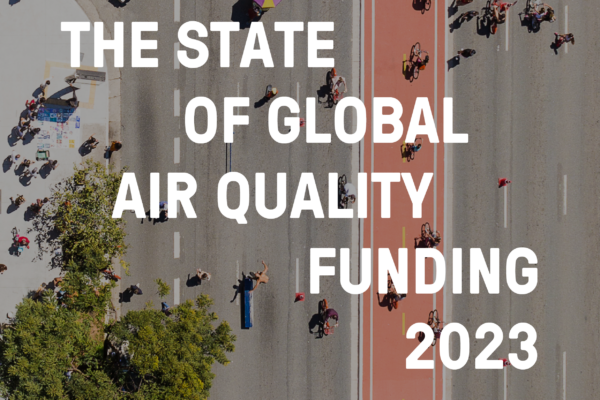Air pollution is the largest environmental threat to human health worldwide, causing 7 million premature deaths every year. Air pollution also exacerbates climate change, harms biodiversity and ecosystems, reduces crop yields and workforce productivity, and damages overall economic activity.
Investing in clean air will mitigate climate change, reduce global health burdens and boost green growth at the same time. The World Bank’s new president, Ajay Banga, recently made access to clean air part of the organisation’s remit, and acknowledged the importance of clean air in delivering development goals. Yet air quality projects continue to be chronically underfunded by donor governments, agencies and multilateral development banks.
But there are positive actions that international donors and national policy makers can take, according to Clean Air Fund’s annual report on the State of Global Air Quality Funding.
Fossil fuel financing is overtaken by air quality for the first time
International development funding for clean air projects has, for the first time, exceeded funding for fossil fuel-prolonging projects, according to the new research. Phasing out this funding, which threatens public health and climate, is imperative to addressing rising temperatures.
The analysis shows that, in 2021, an estimated $2.3 billion was spent on tackling outdoor air pollution in low- and middle-income countries, compared with $1.5 billion on fossil fuel projects, such as oil and gas extraction and production. Global funding for fossil fuel-prolonging projects has declined year-on-year since it peaked at $11.9 billion in 2019, thanks in part to campaigning against such international assistance.
Unfortunately, air quality projects continue to be chronically underfunded by donor governments, agencies and development banks. Between 2015-2021, only 1% of international development funding ($17.3 billion) and only 2% of international public climate finance ($11.6 billion) went towards tackling air pollution.
Who are top 10 funders of air quality projects?
10 donors provided 97% of total outdoor air quality funding in the last five years for which data is available. This high concentration of funding between a few funders indicates limited engagement with air quality issues. This funding base needs to be expanded to match the scale of this global crisis.
| Ranking | Funder | Outdoor air quality funding ($ million) |
Outdoor air quality funding as a % of total finance commitments |
| 1 | Japan | 5,115 | 6% |
| 2 | Asian Development Bank | 5,065 | 5% |
| 3 | Asian Infrastructure Investment Bank |
1,246 | 4% |
| 4 | Canada | 658 | 3% |
| 5 | Republic of Korea | 539 | 2% |
| 6 | World Bank Group | 407 | 0.1% |
| 7 | European Bank for Reconstruction and Development |
299 | 1% |
| 8 | European Investment Bank |
112 | 0.4% |
| 9 | France | 93 | 0.1% |
| 10 | USA | 64 | 0.04% |
| = | All top 10 | 13,597 |
Funders and policy makers need to rewrite the script. They must reassess how they finance climate and air quality projects in tandem if we are to live up to the hopes of the Paris Agreement and Sustainable Development Goals. Only then will we see enough funding to match the size of the opportunity and the scale of this pervasive global problem.
In particular, we urge the World Bank to substantially increase development finance for air quality through its own investments and by driving the clean air agenda with other multilateral development banks at the upcoming Annual Meetings of the World Bank Group and the International Monetary Fund (IMF). Our report highlights how — and where — donors can maximise their resources:
1. Climate finance is an untapped opportunity for win-wins
Only 2% of international public climate finance explicitly tackled outdoor air pollution. The causes and consequences of climate change and air pollution are interconnected, and so are their solutions. It is critical to track the benefits of climate interventions on air quality. Monitoring local air quality benefits – particularly in relation to health – can help to deliver a more comprehensive understanding of the effects of global climate interventions, allowing for more informed decision-making and resource prioritisation.
2. Air quality funding produces massive returns for climate, health and economy
Funding for projects that improve air quality have the potential to shift the dial globally on human health, climate mitigation and adaptation. Every $1 spent on air pollution control can yield an estimated $30 in economic benefits, as the US Environmental Protection Agency found. This means that increasing funding for clean air could help us deliver on several Sustainable Development Goals at once.
But donors are overlooking and underfunding projects that address toxic air. Across both the international development and climate spaces, funders are still only putting a fraction of their money towards the fight for clean air. We need to see a substantial increase in the volume of funding for air quality from OECD-DAC donors, whether channelled through multilateral channels or bilaterally. This includes increasing grant and concessional finances and recalibrating investments to ensure sectors such as agriculture and waste are not left behind. Donors need to fully and transparently account for all benefits (health, climate and sustainable development) that can be delivered through air quality interventions.
3. Focus on underserved countries in the global south
86% of the total $12 billion for air quality was concentrated in China, Philippines, Bangladesh, Mongolia and Pakistan. Meanwhile, other countries in Asia and elsewhere with dangerous levels of air pollution are being overlooked.
Among other gaps, African countries only receive only 5% (or $0.76 billion) of all air quality funding between 2017 and 2021. The continent is home to half of the world’s top ten countries with the highest levels of air pollution. Latin America and the Caribbean received just 1% of the total air quality funding in the same period.
In addition to increasing grant and concessional finance to minimise the debt distress faced by so many countries that receive international aid, the report identifies the need to invest in capacity building and training programmes tailored to air quality management practitioners in low- and middle-income countries.
4. Harness innovative financial instruments
There are a range of financial instruments available to funders with the potential to incentivise and catalyse more funding towards air quality projects. Unharnessed finance vehicles like green bonds, social bonds and results-based funding can create efficiencies and mobilise long-term private capital into air quality projects. So smarter use of these financial instruments by government, international development funders and private investors will catalyse further investment, as the risk is shared.
Which financial instruments are available to donors?
Read our full report for full recommendations for donors
Too often policy makers and donors aim to solve problems one at a time – whether those problems be climate change or health, economic or other crises. But in tackling air pollution, we have a unique opportunity to address several problems simultaneously and advance the sustainable development agenda as a whole….It’s time for policymakers and funders to raise their ambitions.
Rt. Hon Helen Clark, former Prime Minister of New Zealand, former Administrator of the United Nations Development Programme (2009-2017), Board Chair of the Partnership for Maternal, Newborn & Child Health (PMNCH)

